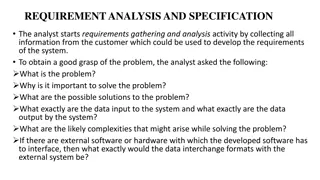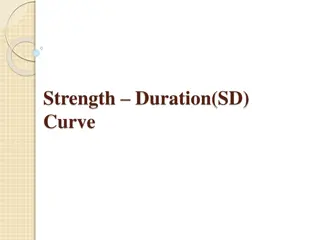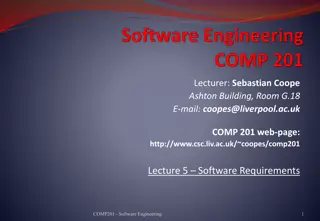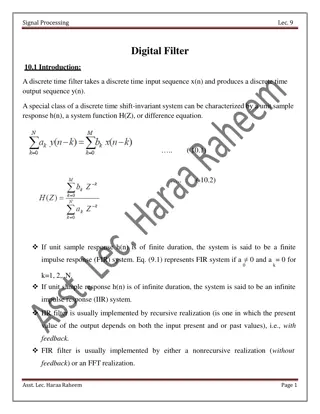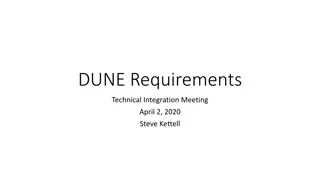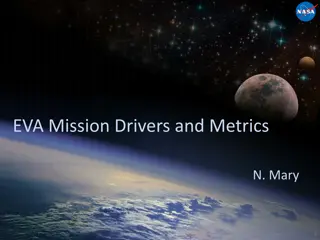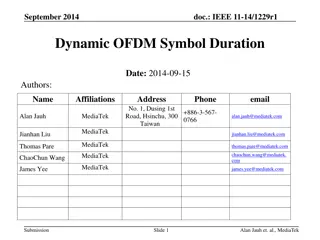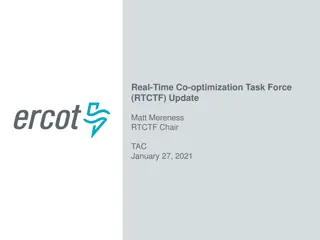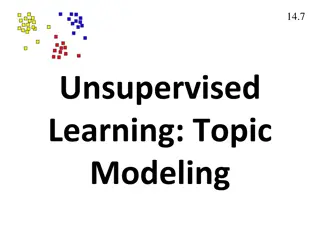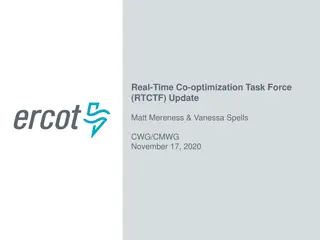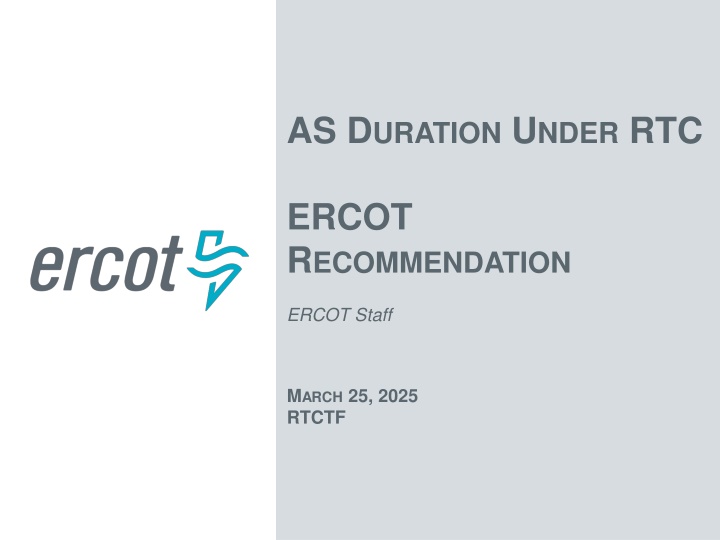
Ancillary Services Duration Recommendations in ERCOT
Learn about the importance of Ancillary Services (AS) in maintaining grid reliability in the ERCOT Interconnection. Explore AS purposes, operational risks, regulatory standards, and duration requirements in ERCOT and other ISOs across North America.
Download Presentation

Please find below an Image/Link to download the presentation.
The content on the website is provided AS IS for your information and personal use only. It may not be sold, licensed, or shared on other websites without obtaining consent from the author. If you encounter any issues during the download, it is possible that the publisher has removed the file from their server.
You are allowed to download the files provided on this website for personal or commercial use, subject to the condition that they are used lawfully. All files are the property of their respective owners.
The content on the website is provided AS IS for your information and personal use only. It may not be sold, licensed, or shared on other websites without obtaining consent from the author.
E N D
Presentation Transcript
AS DURATION UNDER RTC ERCOT RECOMMENDATION ERCOT Staff MARCH 25, 2025 RTCTF
Introduction Purpose of AS Ancillary Services (AS) are an important mechanism for maintaining the reliability of the ERCOT Interconnection. The importance of AS has grown and continues to grow as variability and uncertainty of both supply resources and demands on the grid continue to increase. AS are needed to provide supplemental operational capabilities that would not otherwise be provided solely by, or explicitly incented by, the energy market. AS are procured to satisfy two purposes: 1. Meet certain supply and demand balancing related reliability objectives defined in NERC Reliability Standards, and 2. Reduce operational risks associated with variability and uncertainty. OPERATIONAL RISKOF UNDER COMMITMENTOF RESOURCESTO MEET DEMANDPLUS UNEXPECTED VARIATIONS RELATED BALANCINGI.E. FREQUENCY CONTROL RELATED Need AS Need AS Moment-to-moment balancing of supply and demand; respond to imbalances caused by normal variability and 5-minute net load forecast errors Reserves that can quickly respond to intra- hour net load forecast errors and/or forced outages ECRS Regulation Service Reserves that can respond to multi-hour net load forecast errors and/or forced outages Non-Spin Arrest frequency decline caused by trip of large unit(s) RRS Reserves that can respond to long-duration, multi-hour net load forecast errors and/or forced outages (Under Development) DRRS Restore frequency following trip of large unit(s) ECRS 2 PUBLIC 2
Introduction - Relevant NERC Rules NERC RELIABILITY STANDARD REQUIREMENT SUMMARY BAL-001-2 R1 Maintain 12 month rolling average CPS1 score 100% Average ACE does not exceed Balancing Authority ACE Limit (BAAL) for more than 30 minutes (including during EEA) Balancing Authority (BA) must maintain its annual Frequency Response Measure above its Frequency Response Obligation BA must recover frequency to pre-disturbance value within 15 minutes BAL-001-2 R2 FREQUENCY RELATED BAL-003-2 R1 BAL-002-3 R1.1 BA shall have a plan to maintain contingency reserves to cover the most severe single contingency (MSSC) BAL-002-3 R2 RESERVES RELATED BA must restore its contingency reserve to at least its MSSC within 90 minutes BAL-002-3 R3 Balancing Authority will declare EEA3 when a system s operating reserves are less than its Most Severe Single Contingency (MSSC) and will immediately take actions (including manual load shed) adequate to mitigate this emergency. OPERATIONS RELATED EOP-011 PUBLIC 3
Introduction - Duration in Current RTC Protocols And at other ISOs ERCOT s CURRENT MARKET RULES Real Time Qualification RUC AS Type Protocol Reference 8.1.1.3.1 (2) 8.1.1.3.2 (4) Protocol Reference 8.1.1.2.1.1 (5) 8.1.1.2.1.2 (9) Duration Duration Duration 15 minutes 15 minutes 15 minutes 15 minutes TBD TBD Regulation Service Responsive Reserve Service ERCOT Contingency Reserve Service Non-Spinning Reserve Service *The current RTC gray boxes in these sections are out of alignment with the monitoring criteria and a future NPRR will correct these. 2 hours 8.1.1.3.4 (2) 2 hour 8.1.1.2.1.7 (3)* TBD 4 hours 8.1.1.3.3 (2) 4 hours 8.1.1.2.1.3 (8)* TBD OTHER ISOS A majority of the ISOs in North America have set 60 minutes as the duration requirement for AS. Following are specific details CAISO Duration requirement for Real Time energy: 5 minutes Duration requirement for Real Time AS procurement including Regulation: 30 minutes Duration requirement for DAM & RUC AS procurement: 60 minutes Notes (1) in CAISO ESRs are incented to have a duration of 4 hours due to resource adequacy related requirements; (2) duration requirements are designed to stay compliant with WECC rules; (3) CAISO s ESR fleet is comparable to ERCOT MISO, NYISO, NEISO Duration requirement for Real Time energy: 5 minutes Duration requirement for Real Time AS procurement including Regulation: 60 minutes Duration requirement for DAM & RUC AS procurement: 60 minutes NYISO & NEISO s duration requirements are designed to stay compliant with NPCC rules. 4 PUBLIC 4
Introduction - NPRR1186 is not a good reference for RTC TODAYWITH NPRR 1186 AS is procured in the Day-Ahead Market (DAM) and AS awards are binding to QSEs, not Resources. QSEs assign AS to qualified Resources in Real Time based on their operational plans. AS capacity is not available for SCED until AS is deployed or released. REAL TIME CO-OPTIMIZATION (RTC) AS awards from DAM are a financial obligation and not physical. AS is procured in Real Time. AS awards are binding to the awarded Resource and not QSE (Settlement is QSE-level). Resource s entire capacity (and in case of ESRs their entire stored energy) is available for RTC-SCED to use i.e., either reserve for AS or dispatch as system conditions dictate. There is no concept of a High Ancillary Service Limit (HASL) in RTC-SCED. Deployment of AS like ECRS and Non-Spin effectively occurs when SCED goes short on procurement of ECRS and Non-Spin. AS duration under RTC will be incorporated into the awards a Resource receives. The AS duration parameters in RTC-SCED are the only mechanism available to reserve energy needed in Real Time to respond to unplanned events as they occur this is very different from today where QSEs are relied upon to reserve the capacity. For ESRs carrying "up" AS, 1-hour duration is incorporated into HASL to ensure that SCED Base Point (BP) does not drain the stored energy needed in the balance of the hour to provide up AS. The HASL change only reflects energy needs of the current hour and not any future hours. This approach provides QSEs most flexibility in assigning their Day-Ahead AS awards to Resources that have the best ability to fulfil that obligation based on Real Time operations and avoids stranding stored energy from SCED for several consecutive hours. PUBLIC 5 5
Introduction ERCOTs Analysis and Conclusion To inform appropriate duration needs for every AS type under Real Time Co-optimization (RTC) paradigm, ERCOT has conducted analysis of the (1) duration of historic risks that drive the need for these reserves and (2) length of historic deployment events, some of these deployments occurred in response to the sustained risks. The subsequent slides provide summary of the analysis that was conducted. Below is a summary of the minimum duration for various AS type that ERCOT is recommending based on this analysis. Red text identify values that are different from or not stated in the current RTC Protocols. Real Time Qualification RUC AS Type Protocol Reference 8.1.1.3.1 (2) Protocol Reference 8.1.1.2.1.1 (5) Duration Award and Deployment 1 hour Duration Duration 30 minutes 30 minutes Regulation Service* Responsive Reserve Service (excluding FFR) ERCOT Contingency Reserve Service Non-Spinning Reserve Service 30 minutes 8.1.1.3.2 (4) 30 minutes 8.1.1.2.1.2 (9) 1 hour 1 hour 8.1.1.3.4 (2) 1 hour 8.1.1.2.1.7 (3) 1 hour 4 hours 8.1.1.3.3 (2) 4 hours 8.1.1.2.1.3 (8) 1 hour *Note FRRS is being eliminated with RTC. 6 PUBLIC 6
Grid needs driven by imbalances in supply and demand in Real Time ERCOT has analyzed the amount of time frequency was consistently outside low dead- bands of 59.983 Hz (17mHz) between 2018 and 2024 and observes: Bulk of the events lasted less than 10 minutes. Nearly, 5% of the events in each year lasted between 10 and 15 minutes. A small portion of the events lasted longer than 15 minutes ERCOT has also analyzed consecutive minutes where clock-minute average frequency exceeded ERCOT s NERC established ACE Limit (BAAL). There were 9 events where clock-minute frequency exceeded BAAL for 4 minutes or longer. There were 3 events where clock-minute frequency exceeded BAAL for 15 minutes or longer. 1.35% to 3.24% Key Takeaway: Duration requirements particularly for Regulation and RRS should take BAL-001 compliance needs into account PUBLIC 7 7
Grid needs driven by events that impact SCED availability Planned activities likes site failovers, software patching, password changes and unplanned events like Resource Limits Calculator (RLC) application failure triggered by bad telemetry, backend hardware issues etc., have impacted ERCOT s SCED process in the past. There were eighty such planned and unplanned events between Nov 2013 and Sep 2024 when the SCED process failed but Load Frequency Control (LFC) was functioning. ERCOT engaged the Emergency Base Point (EBP) process in these cases to maintain frequency. Under RTC, when EBP process is engaged, AS awards from the last good SCED will be binding till SCED is restored. Regulation and RRS/PFR will continue to be the first line of defense to maintain frequency. If frequency cannot be maintained, manual actions will be used to issue updated BP to online Resources that have room to respond. In this paradigm, the duration requirement of Regulation and RRS-PFR will influence the volume of manual actions needed to maintain reliability till SCED is restored. Key Takeaway: Duration requirements particularly for Regulation and RRS should take length of EBP events into account. The selected value should try to cover duration of at least some of the most common planned EBP events so that the need for manual actions from Control Room during such common events is minimized. 8 PUBLIC 8
Managing Uncertainty On days when there is a sustained under- forecast in net load and there is some available capacity (assess these are not scarcity days) the typical approach used is, 1. The 10-minute reserve ECRS, is relied upon first to respond to the additional energy need created by the under- forecast in net load. 2. The 30-minute reserve Non-Spin, is relied upon next to relieve/restore the deployed ECRS. 3. The deployed Non-Spin is relied upon till offline unit(s) can turn on to relieve/restore the deployed AS. Use ECRS till Non-Spin supplements the deployed ECRS capacity. Use Non-Spin till offline unit turns on and supplements the capacity needs As a result of the above when considering duration needs, it is important to assess 1. The historical uncertainty in consistently under-forecasting net load A. in 30 minute Ahead timeframe. B. in post RUC timeframe 2. Duration of historic ECRS and offline Non-Spin deployment events Setup: Consider operating on a day with moderate forecasted load during shoulder months with a portion of the generation fleet on outage. A fast-moving weather front causes a large net-load under-forecast error (ex. load picks up significantly, wind drops). Then a large thermal unit gets forced out. 9 PUBLIC 9
30 minute ahead Net Load Under-Forecast Analysis Analysis of sustained under forecast error in the 30 minute ahead net load is included below. When such errors happen, frequency control is impacted and Regulation & PFR become the first line of defense to maintain frequency. ERCOT relies on SCED offsets and ECRS deployments as necessary to recover Regulation & PFR. Key Takeaway: Most extreme under-forecast of 30 minute ahead net load have lasted between 30 minutes and 60 minutes. 10 PUBLIC 10
Historic ECRS Deployment Duration There were 59 ECRS release event between Jun 1, 2023 and Mar 5, 2025. 29 events occurred on capacity short days (i.e., all available units were online) 2 events were related to under generation in SCED 2 events were related to local issues Out of the 26 events that were not on scarcity days and not for local issues and under-generation related, 1 event lasted 165 minutes. Key Takeaway: Excluding November 10, 2024 all otherECRS deployments that were related to ramping have lasted between 30 minutes and 60 minutes. ECRS deployments that were related to frequency have lasted less than 15 minutes. 11 PUBLIC 11
Distribution of Startup Hours of RUCs Jan 1, 2018, through Oct 4, 2024 The startup times of Reliability Unit Commitments (RUCs) between Jan 1, 2018, and Oct 4, 2024, were analyzed. RUC Extensions and RUCs for Congestion were excluded. *The following approach was used to identify low PRC days Between Jan 1, 2018, and Oct 13, 2021, Operating Days with minimum PRC value below 3,500 MW. Beginning Oct 14, 2021, Operating Days with minimum PRC value below 5,000 MW. Between 2018-2024, based on the data analyzed, As can be expected most RUCs are to solve issues during seasonal peak hours. 9% of RUCs (for capacity) had a startup time of 2 hours or less 46% of RUCs (for capacity) had a startup time of 4.95 hours or less 54% of RUCs (for capacity) had a startup time greater than 4.95 hours 51% of RUCs (for capacity) during low PRC days had a startup time greater than 4.95 hours. Key Takeaway: At least 50% of units RUC ed to solve capacity issues have a startup time of 4.95 hours or more. Further the RUC process also typically takes another 20-30 minutes to complete. Using this information, a 6-hour lead time will be used to analyze forecast performance from a perspective of duration needs for Non-Spin. 12 PUBLIC 12
6 Hour Ahead Net Load Under-Forecast Analysis Analysis of the sustained under forecast error in the 6 hours ahead net load included below. When such errors happen, frequency control is impacted and Regulation & PFR become the first line of defense to maintain frequency. ERCOT relies on SCED offsets, ECRS and Non-Spin deployments and Unit Commitment as necessary to recover the deployed reserves. Key Takeaway: Extreme under-forecast of 6 hour ahead net load have lasted more than 4 hours. 13 PUBLIC 13
Duration of Historical offline Non-Spin Deployments There were 122 Offline Non-Spin Deployments between Jan 1, 2018 and Mar 5, 2025. 33 deployments occurred on capacity short days (i.e., all available units were online) 16 deployments were to solve local transmission issues. Out of the 73 events that were not on scarcity days and not for local issues 10 deployments lasted more than 4 hours. 3 deployments lasted more than 8 hours. Key Takeaway: 63 out of 73 Non-Spin deployments that were related to under-forecast in net load or forced outages have lasted up to 4 hours. Remaining 10 Non-Spin deployments have lasted between 4 and 10 hours. 14 PUBLIC 14
May 13, 2022 May 13, 2022 was expected to be a tight operating day. Capacity margin reduced even further due to higher than forecasted net load and approximately 2,422 MW of forced outages that occurred between 11am and 3pm. Non-Spin was deployed for nearly 5.1 hours on this day. (Additional Event Details) 15 PUBLIC 15
March 2, 2025 On March 2, 2025 net load was much higher than forecasted due to a slow-moving low-pressure weather system that impacted wind. Cloud cover, thunderstorm and dust impacted solar and rain chances impacted load. The under forecast of 6 hour ahead (HA) net load lasted for 14 consecutive hours. Non-Spin was deployed for nearly 4.7 hours on this day. 16 PUBLIC 16
Recommendation Below is a summary of ERCOT s recommended duration for AS under RTC and a summary of the key observations that led to these, WHAT WHY Based on historical Non-Spin risk relevant deployments and sustained under forecast error in 6 hour ahead net load, duration of Non-spin should not be lower than 4 hours. In the near term it is worth revisiting this duration to assess its sufficiency specially during more extreme events like May 13, 2022 and March 2, 2025. Non-Spin duration should at least be 4 hours Based length of historical ECRS risk relevant deployments, sustained under forecast error in 30 minute head net load and the need for margin for increases in forecast errors that can be expected with growth in solar, a 1 hour duration for ECRS is appropriate. This duration recommendation may need to be revisited if trends on BAL-002 relevant event recovery durations change. ECRS duration can be changed to 1 hour. Regulation and RRS duration should be changed to 30 minutes. 30 minutes in necessary reduce the risk of ERCOT violating ERCOT s BAL-001 obligation in the event when SCED is not available due to unplanned events. RUC studies should use a 1-hour duration for all AS types excluding FFR. A 15-minute duration should be used for FFR. This aligns AS duration with the study period for RUC. ERCOT is able to rely on deployment factors to flag risky hours and explicitly models SOC across time in the study. 17 PUBLIC 17


